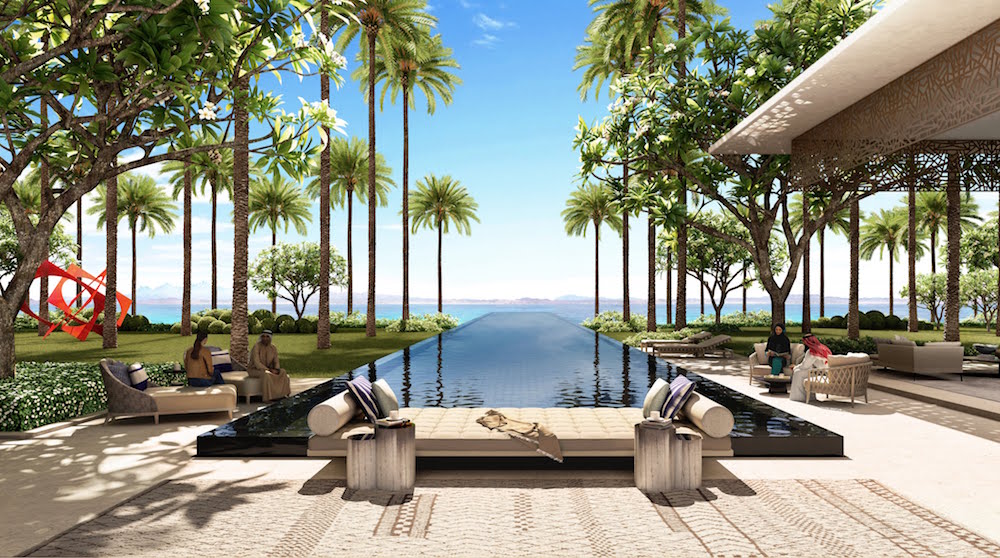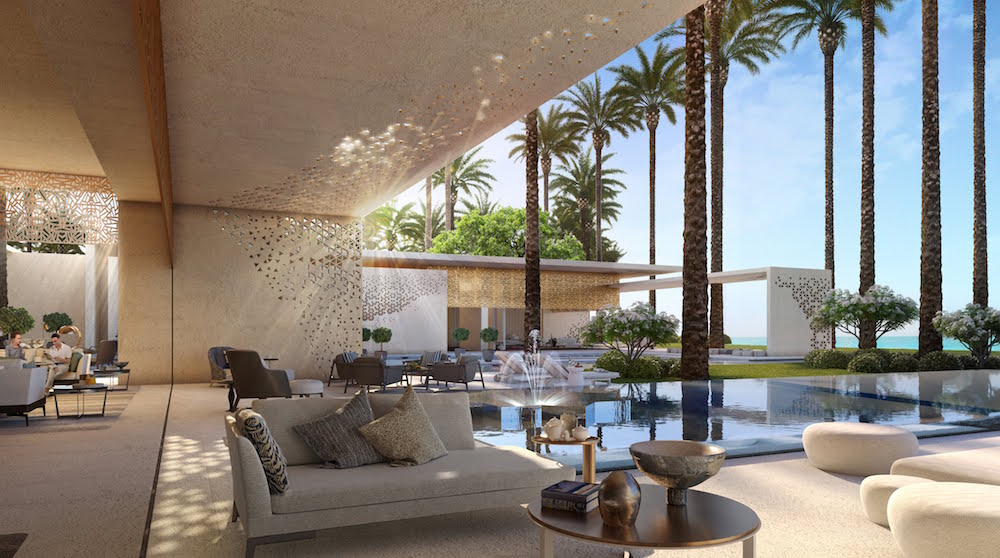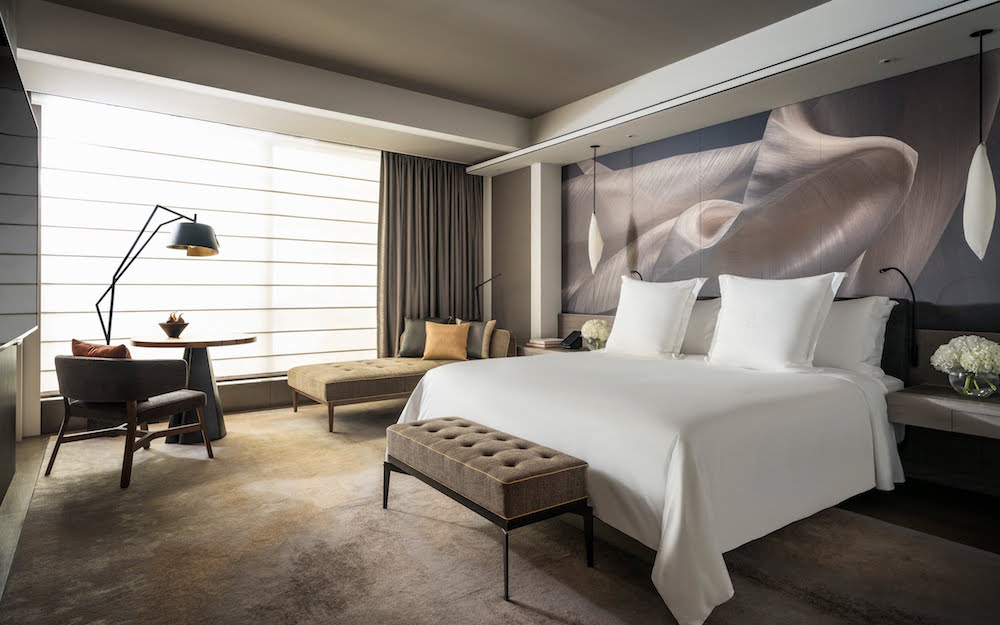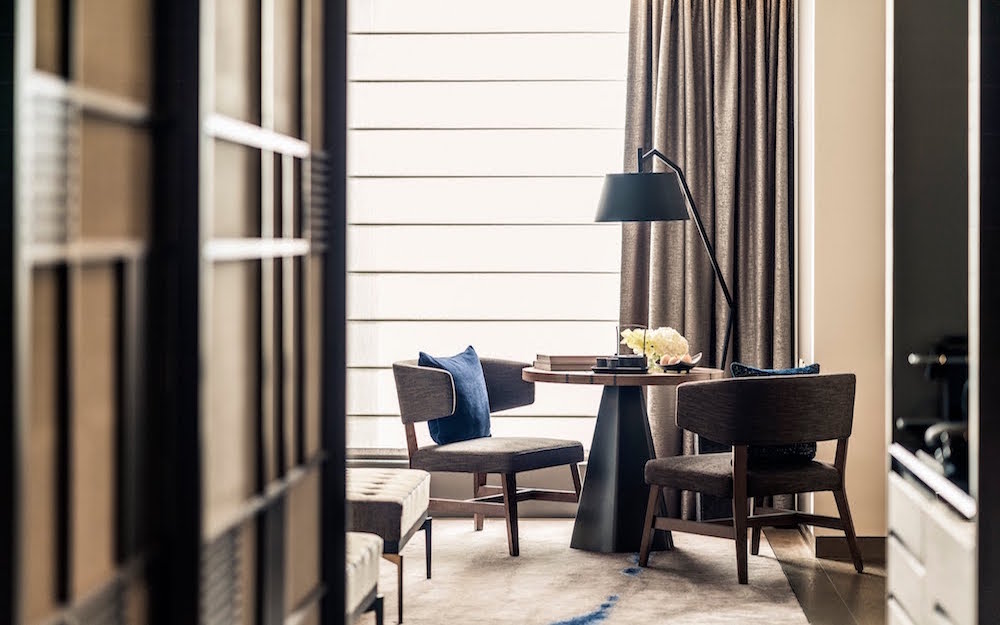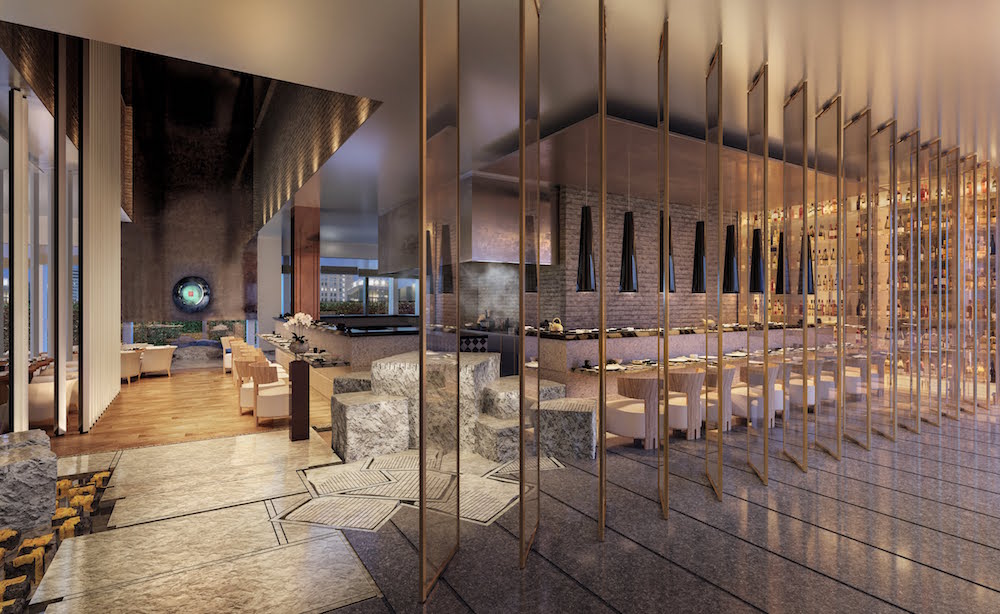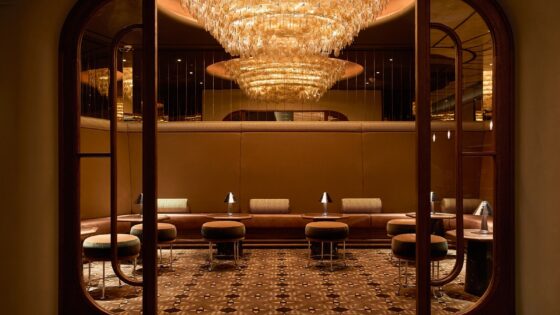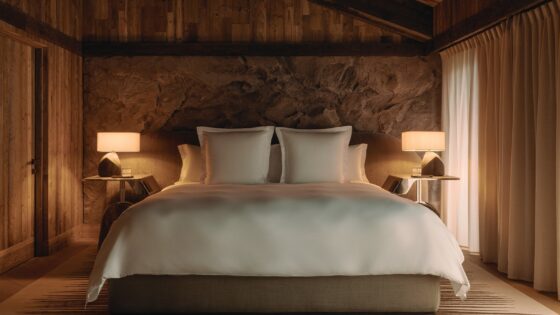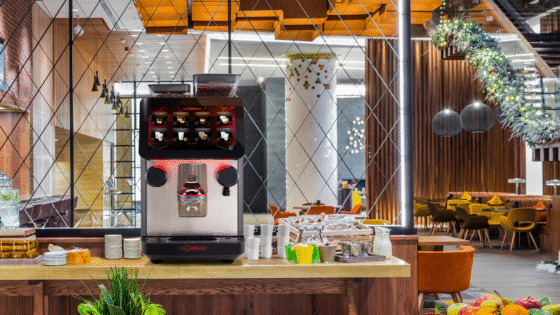If the renders on the boards are anything to go by, Jean-Michel Gathy, who is widely considered as one of the industry’s finest, has embarked on one of his most ambitious hospitality projects to date, to design Amaala Island. Editor Hamish Kilburn learns more…

There is not a hotel designer or architect alive today who has not heard of the name Jean-Michel Gathy, and for good reason. The creative mastermind, who doesn’t just design but more reinvents hotel experiences, has been repainting the backdrop of luxury for what is coming up to three decades.
Not shy of his ambition – he once stated that he wanted to be the first person to design a hotel on the moon – Gathy’s approach to a project is all-encompassing, allowing him to further push (and at times break through) conventional barriers.

Image credit: Capella Sanya, designed by Jean-Michel Gathy/Denniston
His latest project, Amaala Island will be an ultra luxury resort destination spanning three sites, a first for the region of Saudi Arabia. Designed to evolve and elevate the very best in travel, the island is an ultra-luxury destination that focuses on curating transformative personal journeys inspired by arts, wellness and the purity of the Red Sea.
- Image credit: Amaala Island, designed by Jean-Michel Gathy/Denniston
- Image credit: Amaala Island, designed by Jean-Michel Gathy/Denniston
To find out more about the project, and in homage to the designer’s award-winning career, I managed to speak to the architect/designer.
Hamish Kilburn: Jean-Michel, how will the ultra-luxe Amaala Island – aka the “Diamond of the Red Sea” – challenge conventional island developments?
Jean-Michel Gathy: The development of ‘The Island’ will be an immersive and interactive art-inspired jewel. Its lifestyle components, its landscaping, the museums, and art installations together with the art community will transform this island into the “Diamond of the Red Sea”. It will feature many different venues for permanent installations or temporary exhibitions and artistic performances. The graphic layout of its spine will be distinctive from the air and will be recognised internationally as an iconic landmark. The project features all elements programmed and reflects the areas, numbers and facilities. This is truly unique, nothing like it has ever been planned before.
“It’s not a matter of a specific place; it is the fact that when you travel, your mind is continually challenged by the happenings around you.” – Jean-Michel Gathy
HK: How does your approach differ when designing a destination from you’re designing a hotel?
JMG: Constant travel is a huge part of the job. It allows me to observe and to be constantly inquisitive about my surroundings. Travelling builds a subconscious library of ideas, which are expressed in my work and helps my ideas remain innovative and fresh. It’s not a matter of a specific place; it is the fact that when you travel, your mind is continually challenged by the happenings around you. It’s not about where you travel, either – what counts is that you explore. No matter where you are, every country has something new to offer in terms of inspiration.

Image credit: Image credit: The Chedi Muscat, Oman, designed by Jean-Michel Gathy/Denniston
HK: What have been some of your design highlights in your career?
JMG: Perhaps the one for which I am most renowned is the overwater hammocks or ‘basking nets’, which I initiated in the Maldives at the One&Only Reethi Rah in 2000. Until then, you would find balustrades around the terraces of villas. I decided to alter that – if anyone was going to fall off the terrace, they could fall on to the nets. And I put scatter cushions on them.
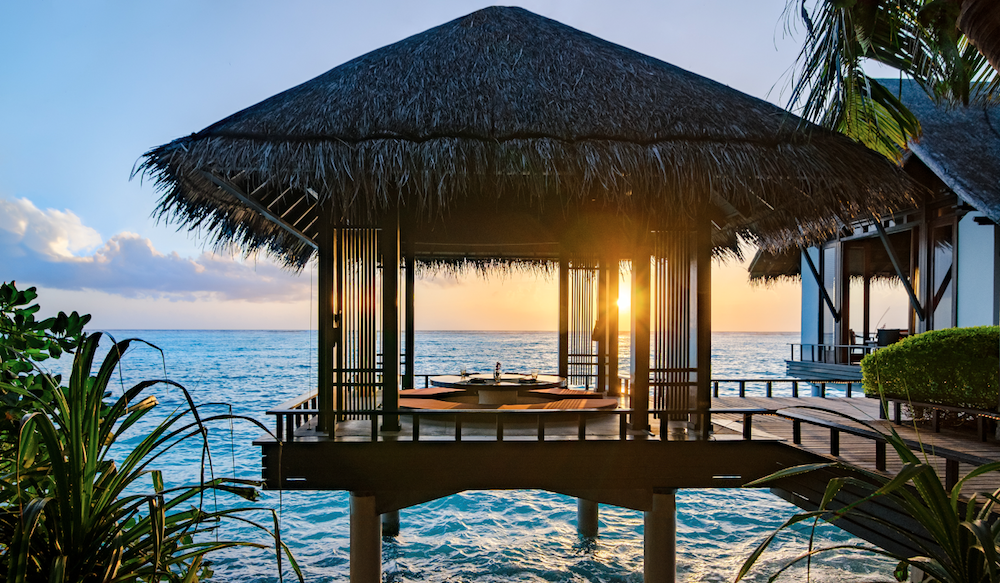
Image credit: One&Only Reethi Rah Maldives, designed by Jean-Michel Gathy/Denniston
Today, just about every hotel uses this idea. Another pioneering step was turning standalone tents for safari-style camps into a commodity. The accommodation at these hotels used to be basic but this started to change after I designed luxurious tents for the Amanwana in 1990. I am also known for my oversized, dramatic swimming pools such as the one on the roof of Marina Bay Sands in Singapore.
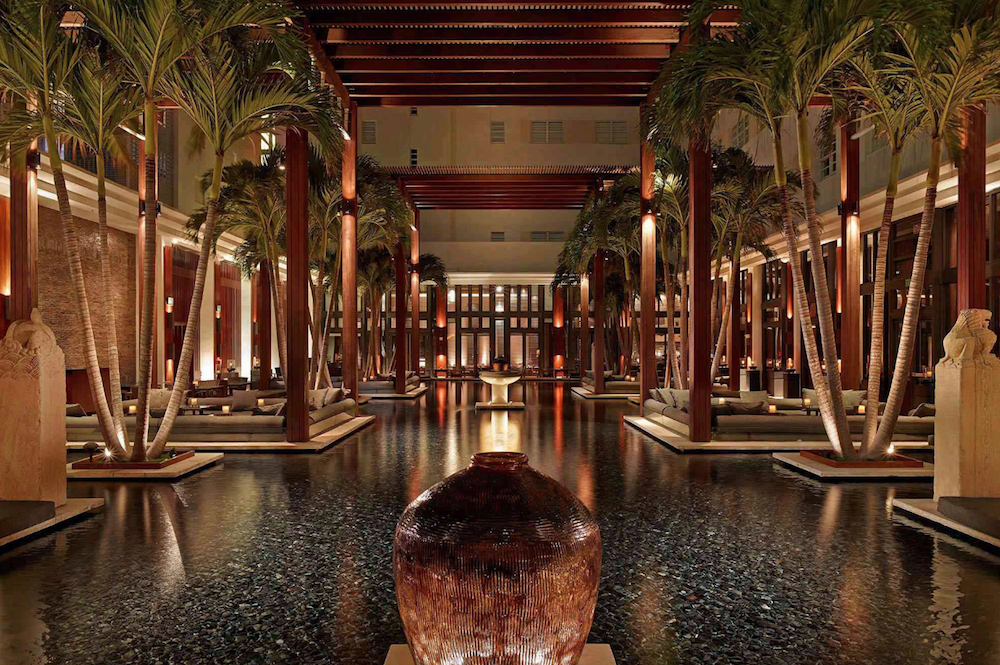
Image credit: The Setai Miami, designed by Jean-Michel Gathy/Denniston
QUICK-FIRE ROUND
HK: What has been the most demanding request you have received from a client to date?
JMG: I guess I take every client that I work with as a challenge more than a demanding request.
HK: Where’s next on your travel bucket list?
JMG: I would love to travel to Iceland to see its rugged landscapes, glaciers, rough seas, hot springs and volcanoes. I’d also like to visit the south of Chile and the peninsula of Kamchatka in Russia, which has extraordinary wildlife and endless forests.
HK: What’s your biggest indulgence when travelling?
JMG: Collecting art – I like to collect and invest in local artwork whilst on my travels.
HK: What lesson would you teach to your younger self?
JMG: The pathway to success is never easy, it takes hard work, dedication and passion.
HK: If you could design a hotel anywhere in the world, where would it be?
JMG: I’d love to design a hotel in Antarctica. There’s an ice hotel in Sweden, but that’s only open four months a year, so I want to do one that permanently remains ice.
HK: What’s been your favourite year on the international design scene?
JMG: To be honest, every year working with my team at Denniston has been and is special to me.
HK: What’s one item you cannot travel without?
JMG: I travel light, but I always ensure I have a cashmere scarf for the plane, and a sweater (I’m a big cashmere fan). I also travel with my camera, a Canon EOS 5D Mark III.
- Image credit: Four Seasons Hotel Tokyo, designed by Jean-Michel Gathy/Denniston
- Image credit: Four Seasons Hotel Tokyo, designed by Jean-Michel Gathy/Denniston
“The hotels where you arrive and lay on the beach and do nothing have progressively disappeared.” – Jean-Michel Gathy.
HK: How is the perception of luxury changing – and how is this evolving the way in which you create spaces in the luxury arena?
JMG: Before, hotels were just a place where you go and relax. Today, guests are connected: they want spas, they want food and beverage, they want activities, they want things to do. The hotels where you arrive and lay on the beach and do nothing have progressively disappeared, because life is such that people have become more and more active. I think luxury property clients are now asking for more than simply great rooms. They want retail facilities, a cinema, an extraordinary spa, award-winning F&B offerings and outdoor activities all integrated into the hotel.
- Image credit: Image credit: Aman New York, designed by Jean-Michel Gathy/Denniston
- Image credit: Image credit: Aman New York, designed by Jean-Michel Gathy/Denniston
“In terms of reliability, price strategy, and brand positioning, Toyota is a fantastic commercial car – but I prefer a Bentley.” – Jean-Michel Gathy.
HK: What’s the value of having designers and architects in your practice?
JMG: There are many good architects, but we have a specific niche. I’m going to compare us to branding: thousands of people buy Toyotas, but few people buy Bentleys. I believe that we are more Bentley than Toyota. This doesn’t mean that a Toyota is not a good car. In terms of reliability, price strategy, and brand positioning, Toyota is a fantastic commercial car – but I prefer a Bentley. Designers are the same; many prefer commercial projects and properties, because their interest is financial. They just want to make money, which means they’re not romantic about their projects. Then you have other designers, which is where I belong, who are more interested in the success of the project, the excitement of the journey of designing a hotel, and having the pride of making something fantastic, even though you earn less money.

Image credit: One&Only Maldives, designed by Jean-Michel Gathy/Denniston
HK: Has the way in which you source inspiration changed over the years?
JMG: I’m someone who designs from the heart so my style is one that’s charismatic. It’s not an ego trip like the architects who design for themselves. I design elements that are a composition of dramatic effect; I create large and dramatic space, in opposition to intimate areas, so the space is always dynamic. Secondly, I design for the sensation you get out of it. I want every space in the hotel to be comfortable and for my clients to come back and say, I like this space. Sometimes they don’t know why they like it, but if they walk in and feel good, I know I’ve succeeded.
And succeeded Gathy has in widening the path of innovative hotel experiences in far-flung destinations around the world. While his past hotel projects have firmly etched his name into the architecture, design and luxury hospitality history books, his latest ideas and concepts that are currently on the boards highlight Gathy and Denniston’s ambitions. Inspired by his worldly perspective of design and architecture, I believe that Gathy’s aspiration is yet to peak as he continues to think big with the future landscape of luxury international hotel design patiently waiting in his sketchbook for its cue to emerge.
Main image credit: Jean-Michel Gathy/Denniston

